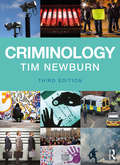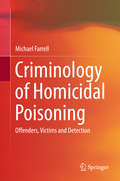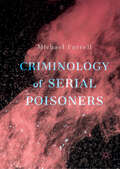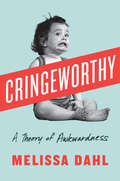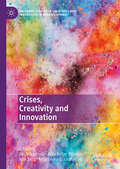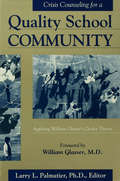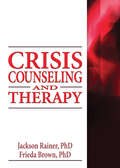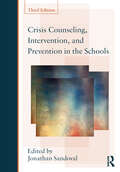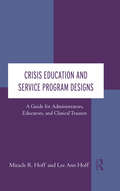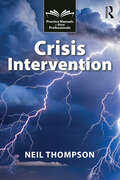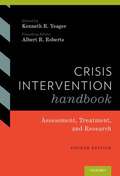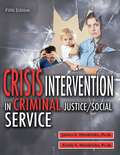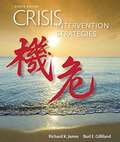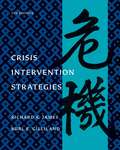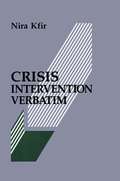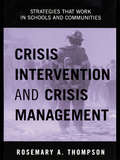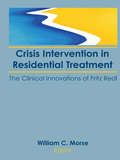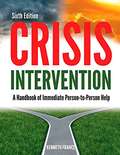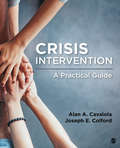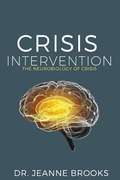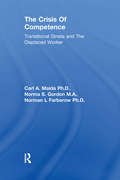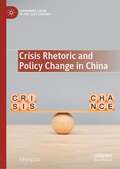- Table View
- List View
Criminology
by Tim NewburnComprehensive and accessible, Tim Newburn’s bestselling?Criminology?provides an introduction to the fundamental themes, concepts, theories, methods and events that underpin the subject and form the basis for all undergraduate degree courses and modules?in Criminology and Criminal Justice. This third edition includes: A new chapter on politics, reflecting the ever increasing coverage of political influence and decision making on criminology courses New and updated crime data and analysis of trends, plus new content on recent events such as the Volkswagen scandal, the latest developments on historic child abuse, as well as extended coverage throughout of the English riots A fully revised and updated companion website, including exam, review and multiple choice questions, a live Twitter feed from the author providing links to media and academic coverage of events related to the concepts covered in the book, together with links to a dedicated textbook Facebook page Fully updated to reflect recent developments in the field and extensively illustrated, this authoritative text, written by a leading criminologist and experienced lecturer, is essential reading for all students of Criminology and related fields.
Criminology of Homicidal Poisoning: Offenders, Victims and Detection
by Michael FarrellThis book provides an overview of historical and contemporary cases of homicidal poisoning. While homicidal poisoning is sometimes thought of as a thing of the past, it continues to be a contemporary problem, and in fact the unknown offender rate for poisoning cases is 20-30 times that of other homicide types in contemporary research, and many poisoners commit serial homicides while going undetected. The author of this important and timely work explores the theoretical bases for understanding homicidal poisoning, the nature of poisons used in homicidal cases, the characteristics of poisoners and their victims, and techniques for detection and prevention. This unique book will be of particular interest to: students of criminology (classes dealing with criminal psychology, and murder investigation); students of the history of crime; criminal justice professionals: attorneys, homicide detectives, forensic pathologists, forensic and clinical toxicologists, and other forensic investigators; and all interested in poisons, poisoners and the detection of poisoning. It has relevance to criminology, law and policing, toxicology and forensic science, the history of crime and detection, and criminal psychology.
Criminology of Serial Poisoners
by Michael FarrellThis book examines serial homicidal poisonings in the modern era, to improve our contemporary understanding of poisons, poisoners, and investigation. Drawing on cases of serial poisoning from around the world, the book defines key terms, examines theories and explanations of serial homicide in relation to serial poisoning, explores the features of the poisons and examines the demographic characteristics of perpetrators of serial poisoning and their victims. It considers healthcare serial poisoning as a specific issue. Overall, it provides an outline for developing a criminology of serial poisoning homicide.
Cringeworthy: A Theory of Awkwardness
by Melissa DahlNew York magazine's "Science of Us" editor explains the compelling psychology of awkwardness, and asks: what if the moments that make us feel most awkward are actually valuable?Have you ever said goodbye to someone, only to discover that you're both walking in the same direction? Or had your next thought fly out of your brain in the middle of a presentation? Or accidentally liked an old photo on someone's Instagram or Facebook, thus revealing yourself to be a creepy social media stalker?Melissa Dahl, editor of New York magazine's "Science of Us" website, has. After a lifetime of cringing, she became intrigued by awkwardness: a universal but underappreciated emotion. In this witty and compassionate book, Dahl explores the oddest, cringiest corners of our world. She chats with strangers on the busy New York City subway, goes on awkward friend dates using a "Tinder-for-friendship" app, takes improv comedy lessons, and even reads aloud from her (highly embarrassing!) middle school diary to a crowd of strangers.After all of that, she realizes: Awkward moments are opportunities to test yourself. When everyone else is pretending to have it under control, you can be a little braver and grow a little bigger--while remaining true to your awkward self. And along the way, you might find that awkward moments unite us in our mutual human ridiculousness.
Crises, Creativity and Innovation (Palgrave Studies in Creativity and Innovation in Organizations)
by Roni Reiter-Palmon Min Tang Zorana Ivcevic Magdalena G. GrohmanThis book aims to provide a better understanding of the different practices of creativity and innovation under crisis situations. Drawing on theories and studies by scholars in psychology, education, and organizational behavior, this edited collection brings together renowned international experts to explore the active and reactive adaptations to the transformations caused by crises. It discusses how abrupt changes in personal, social, political, economic, or environmental affairs are an integral part of our individual and social lives, which drive people and organizations to adapt and change. With flexibility, adaptability, and problem-solving at the core of its nature, creativity and innovation have the potential to help people cope with harsh and uncertain circumstances caused by crises. This book delves into the positive relationship between the experience of crisis and creativity and innovation, presenting theoretical inquiries, empirical studies, and their practical implications for a constructive shift in crisis management, coping mechanisms, and individual and societal wellbeing. A must read for researchers in psychology, philosophy, sociology, economy and politics, interested in crisis and disaster studies.
Crisis Assessment, Intervention, And Prevention
by Bradley T. Erford Lisa R. Jackson-CherryThis text provides crucial help for mental health professionals in assessing and reacting to various crises involving suicide, homicide, intimate partner violence, sexual violence, sexual abuse, bereavement/grief, substance use, natural disasters, wars, and terrorism. Included are practical applications to various crisis situations experienced by counselors and first-hand experiences and perspectives from practitioners working in crisis-intervention situations. <P><P>The text features a comprehensive crisis task model and numerous crisis situations not found in other crisis texts, and it shows the process as a whole through descriptions of crucial information, clinical considerations, and practical experiences on every crisis topic. <P><P>Thoroughly current throughout, the new edition includes new chapters addressing counselor safety issues, counselor self-care and wellness issues, and new and expanded chapters addressing Emergency Response in the Community and in Schools. <P><P> An effective training tool for various mental health professionals in the field, it covers the perspectives and roles of clinical mental health counselors, school counselors, and pastoral counselors when assisting in crisis situations. <P><P>Similarly, schools of social work, psychology, and criminal justice will find applicable information for how to address crisis situations. Graduate programs as well as upper level undergraduate programs will find the book an ideal text for teaching crisis intervention.
Crisis Counseling For A Quality School: A Family Perspective
by Larry PalmatierThe theory of crisis counselling put forward in this book is applied to the following situations: drug and alcohol abuse; depression and suicide; physical and sexual abuse; social and discipline problems; lateness; encopresis and enuresis; fear, teariness, inactivity, fury and impulsiveness; violence and conflicts; children of divorced and foster families; loss and grief; war and disasters; parents in crisis; homelessness, crack kids and AIDS children; and defiance, inter-racial tensions and cross-cultural conflicts.
Crisis Counseling and Therapy
by Jackson Rainer Frieda BrownComprehensive instruction in this important method From Pearl Harbor to the events of September 11, 2001, to the ravages of Hurricane Katrina, tragedy can leave indelible scars. Its many forms are now visibly present in our local, national, and international communities. Intervention, as a clinical technique to combat the debilitating effects of stress that accompany crisis, is quickly becoming a social movement. Crisis Counseling and Therapy provides comprehensive instruction in this important and rapidly burgeoning field with a systemic three-phase method that is simple and practical. This innovative model can easily be incorporated into the clinician&’s practice to provide effective, strategic intervention. Crisis Counseling and Therapy recognizes that no single theory or strategy will prove useful in all situations and so offers students and professionals an adaptable approach to dealing with any crisis they may confront. By integrating four proven theories-narrative, cognitive-behavioral, family systems, and experiential/existential-and using the degree of disequilibrium experienced in the system to determine therapy sessions, this unique text presents a new approach to crisis work. In-depth, contemporary case studies and an easily-learned and -implemented model of application allow for multidisciplinary approaches to treatment and more positive, constructive outcomes. Topics covered in Crisis Counseling and Therapy include: definitions of crisis critical moments of development characteristics of the crisis counselor contemporary standards and models of practice models for intervention assessment models models of treatment justification for a new model of treatment-restoration of functioning integrating the four unique approaches profile of an individual in crisis the systemic crisis intervention model the model&’s three phases: Remember, Reorganize, Restore integrating the stress of crisis and many more! A vital text, reference, and resource manual, Crisis Counseling and Therapy is ideal for students and established professionals as well as clinicians and specialists working in the fields of psychiatry, psychology, social work, nursing, organ donor procurement, first responder personnel, ministry, emergency medicine, and managed care who are seeking continuing education.
Crisis Counseling, Intervention and Prevention in the Schools (Consultation, Supervision, and Professional Learning in School Psychology Series)
by Jonathan SandovalSince the first edition was published in 1988, the role of crisis intervention and prevention has become central to mental health professionals working in the schools. Disasters such as hurricane Katrina, terrorist attacks both in this country and around the world, and various school shootings have greatly increased school crisis research and policy development. This book is designed for an introductory graduate course taken by students in school psychology, school counseling, and school social work. Section I provides a crisis response overview, section II deals with crises for children and adolescents and section III covers crises that manifest in adolescence. Discussions of the 16 most prevalent types of crises are covered in sections II and III and include their characteristics, causes, interventions, and preventive programs. All chapters will be updated, six heavily revised or totally rewritten by new authors, and two new chapters (chapters 8 & 19) have been added.
Crisis Education and Service Program Designs: A Guide for Administrators, Educators, and Clinical Trainers
by Lee Ann Hoff Miracle R. HoffCrisis Education and Service Program Designs, is a guide for educators, administrators, and clinical trainers who may otherwise feel ill-prepared for the complex tasks of teaching, program development, supervision, and consultation in the crisis-care arena. The book provides a framework for more systematic inclusion of crisis content in health and human-service programs. Readers will find that this book fills the current gaps in knowledge and training, and fosters a more holistic practice by all human-service professionals. It shows how effective leadership, training, and timely support contribute to crisis workers’ effective practice with people in crisis.
Crisis Intervention (Practice Manuals for Busy Professionals)
by Neil ThompsonThis new edition provides essential reading on crisis intervention for social workers, mental health nurses and other human services practitioners and managers. What defines a crisis can often be misunderstood and incorrectly equated with emergencies. This book explores crisis theory in depth, providing updated and refreshed guidance on what a crisis entails and how to effectively manage traumatic situations. In three distinct parts, the text challenges the dominant individualistic thinking about crises and instead adopts a holistic focus. It expands on crisis theory, examines the implications arising from crises, including links with trauma and the need to address discrimination and oppression. Key points, tips, opportunities for reflection and illustrative case studies are provided to aid understanding and help readers feel confident in tackling crisis intervention to bring about positive outcomes.
Crisis Intervention Handbook: Assessment, Treatment, and Research (Fourth Edition)
by Kenneth Yeager Albert RobertsFewer concepts in American society have received more attention recently than the need for skilled crisis intervention. Images of crises inundate internet and newspaper headlines, television screens and mobile devices. As a result of the growing amount of acute crisis events portrayed in the media that impact the lives of the general public, interest in crisis intervention, response teams, management, and stabilization has grown tremendously. Skills and methods to effectively manage acute crisis situations are in high demand. While many claim to understand the rapidly growing demand for effective crisis management, few provide clearly outlined step-by-step processes to educate and guide health and mental health professionals. This is a thorough revision of the first complete and authoritative handbook that prepares the crisis counselor for rapid assessment and timely crisis intervention in the 21st century.
Crisis Intervention In Criminal Justice/Social Service (Fifth Edition)
by James E. Hendricks Cindy S. HendricksThis expanded new edition continues to demonstrate and provide theoretical, analytical, and practical knowledge for first responders. Face-to-face interaction with the client/victim is part of the comprehensive approach advocated by the book, which requires interveners to assess the nature of a crisis and the condition of the victim in order to determine the appropriate course of action. The comprehensive balance of theory and practice presented in this book should enable the intervener in coupling his/her general knowledge of human psychology and emotional crisis with the specific and novel characteristics of various crisis situations. The text represents the work of national scholars who have expertise in criminal justice and social service issues. Their chapters focus on a Historical and Theoretical Overview, Ethics in Crisis Intervention Practice, Intimate Partner Violence, Police Response to Domestic Violence, Children in Crisis, Elder Mistreatment, Suicide, Crisis of Rape and Survivor Intervention, Death Notification and the Theory and Practice of Delivering Bad News, Terrorism and Crisis Intervention, and Mass Casualty Crisis Response and Communication. Helpful appendices in each chapter provide additional internet resources, as well as a complete Model Law Enforcement Code of Ethics and Social Work Code of Ethics. This new edition retains important information while providing current case studies such as the "Miracle on the Hudson River" crash, the mass shootings at Virginia Tech, the Boston Marathon bombing, and the Yarnell Hill fire in Arizona. This exceptional book is designed for firefighters, police officers, community service officers, correctional workers, emergency medical workers, probation/parole officers, protective service workers, psychological counselors, social workers, and victim assistance workers among others.
Crisis Intervention Strategies
by Richard James Burl GillilandThis authoritative, best-selling text presents the latest skills and techniques for handling crisis situations. <p><p>The authors' task model clearly illustrates and elucidates the process of dealing with people in crisis, from defining the problem to obtaining commitment. Using this model, the authors build specific strategies for handling a myriad of different crisis situations, accompanied in many cases with the dialogue that a practitioner might use when working with the individual in crisis. This book puts you on the front lines with the crisis worker throughout the chapters, and then illuminates the techniques and strategies the worker used. <p><p>New videos in MindTap (available with the text) correlate with the text and demonstrate crisis intervention techniques, ensuring that you not only understand the theoretical underpinnings of crisis intervention theories, but also know how to apply them in crisis situations.
Crisis Intervention Strategies 7th Edition
by Richard K. James Burl E. GillilandThis authoritative, best-selling text presents the latest skills and techniques for handling real crisis situations. The authors' six-step model clearly illustrates and elucidates the process of dealing with people in crisis: Defining the Problem, Ensuring Client Safety, Providing Support, Examining Alternatives, Making Plans, and Obtaining Commitment. Using this model, the authors then build specific strategies for handling a myriad of different crisis situations, accompanied in many cases with the dialogue that a practitioner might use when working with the individual in crisis.
Crisis Intervention Verbatim
by Nira KfirFirst published in 1989. Routledge is an imprint of Taylor & Francis, an informa company.
Crisis Intervention and Crisis Management: Strategies that Work in Schools and Communities
by Rosemary A. ThompsonThis book discusses steps helping professionals should take in order to prepare for a crisis in their schools and community. The author introduces a Crisis Management Plan, which discusses ways to restore a school/community to its pre-crisis equilibrium. The author also includes information on how schools should talk to media personnel and parents in times of a crisis, checklists, assessment instruments, and sample documentation forms that can be used in times of a crisis.
Crisis Intervention in Residential Treatment: The Clinical Innovations of Fritz Redl
by William C MorseAll settings where disturbed children spend time, such as camps or residential schools, are periodically faced with crisis situations. Methods for dealing with these crises and for counseling the children involved are continually needed. Crisis Intervention in Residential Treatment is both a demonstration of how essential Fritz Redl’s treatment concepts remain today and a tribute to his genius. The authors bring order and reason to the quest for better ways to understand and respond to confrontation and aggression in residential treatment settings. They provide practical and successful strategies to cope with these situations and prevent them from occurring. By exploring and expanding some of Redl’s most important theories and practices, the authors encourage a new generation of child care workers to find the same stimulation and satisfaction in his work as his original followers found. The contributors, each deeply affected and influenced in his or her own way by Redl, provide not only a moving tribute to a great child care worker and innovator, but also a rejuvenation of some of the most valued ideas in the field.Sharing Redl’s concern for daily practice with very difficult youngsters, this understanding book focuses on the action setting and the development of theory from practice, not the application of theory to practice. By concentrating on such topics as the use of life space interviewing, aggression and counter-aggression in staff, and the contrast of interpersonal and ecological perspectives with current “get tough” approaches, Crisis Intervention in Residential Treatment is an eminently useful guide for everyone dealing with children in group settings. Psychiatrists, psychologists, social workers, teachers, and residential personnel will all learn effective ways of coping with and preventing crisis situations.
Crisis Intervention: A Handbook Of Immediate Person-to-person Help
by Kenneth FranceIn this exceptional new sixth edition, the author has retained the practical framework for offering immediate problemsolving assistance to persons in crisis. Therefore, the goal of this updated and expanded edition is to provide knowledge and methods applicable to particular crisis circumstances. Specific topics include: core concepts that are fundamental to all intervention efforts, crisis theory and the philosophy of crisis intervention, basic communication and problemsolving skills, suicide prevention, assistance for terminally ill persons, bereavement counseling, intervention with crime victims, rape counseling, negotiating with armed perpetrators, group strategies, family and marital interventions, disaster relief, case management, physical facilities, modes of contact, community relations, selection, training, and burnout prevention procedures. The handbook also details a review of the research on crisis intervention and how individual intervenors can build upon that knowledge. Numerous case examples presented in the handbook (with fictitious names) are based on actual occurrences the author has encountered. The techniques in this book are applicable to crisis centers, hotlines, Internetbased services, victimassistance programs, college counseling centers, hospitals, schools, correctional facilities, children and youth programs, and other human service settings. The Study Questions at the end of each chapter are designed to serve as useful applications of crisis intervention theories and principles. Intended for caregivers whose work involves crisis intervention efforts, this is an informative resource for counselors, social workers, psychologists, nurses, physicians, clergy, correctional officers, parole and probation officers, and lay volunteers.
Crisis Intervention: A Practical Guide (Crisis Intervention Ser.)
by Joseph E. Colford Alan A. CavaiolaCrisis Intervention takes into account various environments and populations across the lifespan to provide students with practical guidelines for managing crises. Drawing on over 25 years of relevant experience, authors Alan A. Cavaiola and Joseph E. Colford cover several different types of crises frequently encountered by professionals in medical, school, work, and community settings. Models for effectively managing these crises are presented along with the authors’ own step-by-step approach, the Listen–Assess–Plan–Commit (LAPC) model, giving students the freedom to select a model that best fits their personal style or a given crisis. Future mental health professionals will gain the knowledge, skills, and confidence to help their clients manage the crises they will encounter in their day-to-day lives.
Crisis Intervention: A Practical Guide (Crisis Intervention Ser.)
by Joseph E. Colford Alan A. CavaiolaCrisis Intervention takes into account various environments and populations across the lifespan to provide students with practical guidelines for managing crises. Drawing on over 25 years of relevant experience, authors Alan A. Cavaiola and Joseph E. Colford cover several different types of crises frequently encountered by professionals in medical, school, work, and community settings. Models for effectively managing these crises are presented along with the authors’ own step-by-step approach, the Listen–Assess–Plan–Commit (LAPC) model, giving students the freedom to select a model that best fits their personal style or a given crisis. Future mental health professionals will gain the knowledge, skills, and confidence to help their clients manage the crises they will encounter in their day-to-day lives.
Crisis Intervention: The Neurobiology Of Crisis
by Jeanne BrooksThis manual is meant to help people through crisis. The author has worked in the mental health field for over thirty years with a specialty in crisis and for the last ten years, she has been training counseling students in crisis intervention. Natural disasters, mass shootings, refugee crises, human sex trafficking, etc. show the growing need for individuals to be prepared to sit with others in their suffering. The need is growing, yet the workers are few. The author has recognized that more and more organizations, disciplines, and ministries are doing crisis intervention with little to no knowledge or understanding of the effects that working with people in crisis has on the crisis worker. This manual will help gain a better understanding of how trauma effects an individual, as well as how working with people in crisis can affect the interventionist. This information can help work more effectively by training the team members in self-sustainment. This Christian perspective of intervention will help crisis interventionist and the agency become more Christ-like in their approach by instilling a confidence and hope in the most horrific of circumstances, while still maintaining strong faith in the goodness of God. The preventative practices provided in this manual will help prevent burnout, compassion fatigue and vicarious trauma for crisis interventionist.
Crisis Intervention: Using Tipping Points to Achieve Transformative Change in Therapy
by J. Scott FraserThis book shows mental health providers how to envision crises as time-limited windows of opportunity—as tipping points clients can seize to achieve new insights and move in positive directions in their lives. Most mental health practitioners have been taught to do risk assessments and to reduce danger to their clients and those around them. However, many providers lack a thorough understanding of the cause and nature of mental health crises and struggle to safely and successfully provide crisis intervention. Instead of seeking to return clients in crisis to their previous baseline, providers can seize the opportunity presented by crises and tip them toward rapid resolution. In Part One of the book, J. Scott Fraser outlines his Process of Change model, a clear and concrete approach to understanding crises in their proper context; engaging with clients through their values, culture, and language; honoring their goals; and breaking cycles of crisis for good. In Part Two, he shows how different types of crises—trauma, suicidality, grief, intimate partner violence, and sexual assault—reflect similar vicious cycles. Real life case studies illustrate the Process of Change model in action, demonstrating how each of those cycles can be tipped toward resolution by embracing the contextual process of change perspective.
Crisis Of Competence: Transitional Stress & The Displaced Worker
by Maida Et Al.First published in 1990. Routledge is an imprint of Taylor & Francis, an informa company.
Crisis Rhetoric and Policy Change in China (Governing China in the 21st Century)
by Yihong LiuThis book explores how China's political system responds to crisis. A crisis is an episode whose impact cannot be controlled merely by astute on-the-ground incident management, particularly in cases involving widespread doubt about the legitimacy of established policy paradigms or the political order as a whole. Crisis can create “political windows” for advocacy groups challenging established policies in pluralist democracies. The political battle between competing definitions of an uncertain and ambiguous situation among the various actors provides them with crisis-induced opportunity space for dramatic policy change. However, the process of crisis-induced policy change, mainly by crisis framing, in non-west regimes like China has not been adequately addressed. As China's leadership foregrounds legitimacy in “victory” over COVID-19, and a new era of climate change disasters begins, this dynamic model of crisis and recuperation will offer food for thought for scholars of Chinese and global politics.
